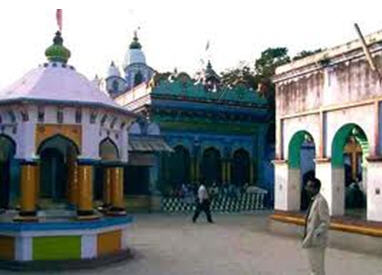Sri Kaisoranandadeva Gosvami, a disciple of Rasikananda wrote a book in Oriya, the language of Orissa, telling how the Gopinatha Deity came to Remuna from Chitrakoot.
The book relates that in Treta-yuga, more than a million years ago, the Supreme Lord Ramacandra and His wife, Sita Devi, lived for some time at Chitrakoot, in north central India. Once during the rainy season a strong storm forced Rama and Sita to take shelter in the ashrama of some sages. On seeing the many cows in the ashrama and hearing their mooing, Lord Ramacandra told Sita, “Seeing all these cows, I’m reminded of My pastimes in Dvapara-yuga.” Lord Rama was referring to His later appearance as Lord Krishna.
Sita Devi said, “What do You mean? Please tell me about those pastimes.”
Lord Rama replied, “Just wait a week. With an arrow I’ll carve some pictures of those pastimes in a black rock, and you will be able to see them.”
But after four days Sita said, “I can’t wait any longer. Please show me what You’ve done.”
To please her, Lord Ramacandra then showed her the carvings. He had completed a Deity of Gopala Krishna (His back still attached to the stone) and, on the stone itself, drawings of Krishña's eight principal gopis (cowherd girlfriends) and four maid-servants to the gopis. Also depicted were twelve cows, Lord Balarama wrestling Mustika, Lord Krishna wrestling Canura, and a few other scenes.
Pleased to see all this, Sita began worshiping the Gopala Deity at Chitrakoot.
After a few days Rama and Sita left, so Lord Brahma, the creator of the universe, came and took over the worship of the Deity (a service he was to perform through the rest of Treta-yuga, through Dvapara-yuga, and for several centuries of Kali-yuga).
When Lord Ramacandra returned to India from Lanka after killing the demon Ravana, He stopped for four days at the place now known as Remuna in orissa. Sita Devi wanted to bathe there in the Ganges, so Lord Rama shot seven arrows into the ground and brought forth the Ganges. Today that place is called Saptashara, “seven arrows.” A deity of Lord shiva named Gargasvara was later installed there. Near-by stands a deity of Durga Devi known as Ramachandi. Because Lord Ramacandra felt pleasure (raman) at that place, it came to be known as Remuna.
In the thirteenth century King LangulaNarasimhadeva from Orissa was travelling to holy places with his queen and many great sages. At Chitrakoot they saw the Deity of Gopala. Not knowing that Lord Brahma was coming there daily, the king was astonished that no one was worshiping such a beautiful Deity.
That night the Deity appeared to the king in a dream and asked to be taken to a more populated place. The king decided to take Gopala to JagannathaPuri.
The king selected some qualified brahmanas to worship the Deity and started for Puri. But when they reached Remuna, a beautiful cowherd village, Gopala again appeared to the king in a dream and asked to be installed and worshiped there. The village people, delighted, gave the Deity large quantities of milk and milk products every day. The queen noticed that the Deity was accompanied by carvings of the eight principal gopis, so she named Him Gopinatha, “Lord of the gopis.”
NOT LONG AFTER the time of CaitanyaMahaprabhu, a king who was a Deity hater was going around smashing Deities in temples. When the people of Remuna heard he was coming, they hid Gopinatha in a pond three miles away. The king was upset that he could not find Gopinatha, so he struck and partially broke Ramachandi, the Durga deity.
Meanwhile, a great devotee named Rasikananda received an order in a dream to excavate the pond where Gopinatha had been hidden. He recovered the Gopinatha Deity, built a temple for Him, and took charge of His worship.
Rasikananda was the foremost disciple of Shyamananda, who had helped transport from Vrindavana to Bengal the writings of the Gosvamis, leaders in Lord Caitanya’s movement. Shyamananda had spread Krishna consciousness extensively in Orissa, where Rasikananda had become his disciple.
When Rasikananda decided it was time to leave the world, he went into the Gopinatha temple and disappeared. He had been performing sankirtana in the temple courtyard with seven of his associates, and now his associates were so overwhelmed by spiritual separation that they too gave up their bodies and entered the spiritual world.
The samadhis (tombs) of Rasikananda and these associates stand outside the temple. Each spring the people of Remuna hold a twelve-day festival to commemorate the passing of Rasikananda.
SripadMadhavendraPuriGoswami once while travelling to puri came here. While here he had a desire to taste the famous Khira (sweet rice) offering made for Gopinath . He wanted to cook a similar offering for his deity of Gopal at Govardhan. Reciprocating with his desire, Lord Gopinathstole a pot of sweet rice and kept it behind the altar. Pujari of the temple got a dream of Gopinath telling him that he has stolen this pot and that it should be handed over to his dear devotee MadhavendraPuri. From that day on Gopinath came to be called as KhirachoraGopinath.
Visiting Remuna
THE BEST WAY to get to Remuna from Calcutta is to take a train from Howrah station to Baleshwar (Ballasore), about a five-hour trip, depending on the train. From Baleshwar you can go the twelve kilometers to Remuna by taxi, auto riksha, or bus.

